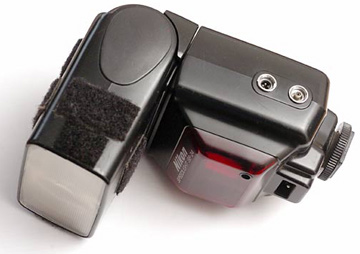 Interfit has released some pretty cool-looking speedlight accessories and bracket system under a line called "Strobies."
Interfit has released some pretty cool-looking speedlight accessories and bracket system under a line called "Strobies."Name similarities aside, there is absolutely no connection of any kind between this site and the Strobies XS stuff. And from a quality of light standpoint I really dig where they're going. My concern is how well the math holds up.
More wishy-washy waffling and indecisiveness inside...
__________
 Remember when we talked about the difference between a speedlight and a mono with respect to the architecture of the tube and reflector?
Remember when we talked about the difference between a speedlight and a mono with respect to the architecture of the tube and reflector? This new mounting frame, left, brings the two different types of flashes together in terms of quality of light. At first glance it looks like any one of several DIY speedlight-into-softbox mounts, but they take it a step further and include a system-oriented mounting flange at the business end.
Now, the flash head (mounted into a beauty dish / soft box / reflector / etc.) has its light positioned in the focal point of the light modifier. The diffuser dome sends the light out in all directions, completing the deal.
This architecture (or, rather, the lack of it) is what is wrong with just about every DIY speedlight beauty dish. David Tejada's version comes close, but still does not duplicate the bare-tube-and-beauty-dish combo.
So, What's Not to Like?
 Think about what has to happen for that speedlight to get to the quality of a decent-sized bare tube mono. The tiny little flash tube emits light, it is reflected (with some loss) by the built-in reflector and thrown forward. Then it is collected and diffused by the plastic dome.
Think about what has to happen for that speedlight to get to the quality of a decent-sized bare tube mono. The tiny little flash tube emits light, it is reflected (with some loss) by the built-in reflector and thrown forward. Then it is collected and diffused by the plastic dome. This diffuser dome step eats up a lot of light, and it happens before the light ever gets to the first light-sucking bounce or diffusion surface of any of the Strobies mods. Thus, high 9's on quality of light, and (an estimated) low 6's for efficiency -- I would not expect a lot of output along with that beautiful light quality.
Maybe a Mono?
In essence, you are spending both dollars and lumens to get your speedlights to create the same quality of light as monoblocs.
They look very well made, and I would be curious to see a price list. Because for the cost of outfitting one of these strobe-to-quasi-mono setups, you may well be able to pick up an actual, small monobloc. I am thinking AB400 or Elinchrom D-Lite, maybe. And you would still need a speedlight to stick inside the "Strobie" if you went that route.
If you already have the speedlight of your dreams, and are working indoors for close-in portraiture, the "Strobies" might be just the ticket. This is especially true if you are looking for beautiful, beauty dish light and TTL workflow. That's a plus the monos don't offer. But if you need high quality and high quantity light, be sure to take a look at all of the factors before you make the jump.
These are new, and I haven't seen any prices yet. So a lot will depend on that. Please update us in the comments if you see any hard numbers floating around.
__________
More info: Interfit Strobies XS























